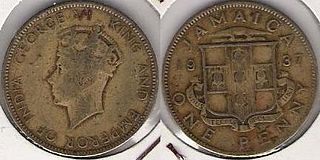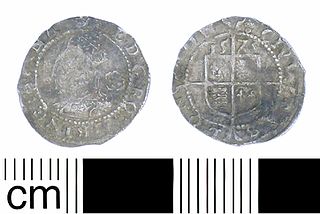
The standard circulating coinage of the United Kingdom, British Crown Dependencies and British Overseas Territories is denominated in pennies and pounds sterling, and ranges in value from one penny sterling to two pounds. Since decimalisation, on 15 February 1971, the pound has been divided into 100 (new) pence. Before decimalisation, twelve pence made a shilling, and twenty shillings made a pound.

The half farthing was a British coin worth 1⁄1920 of a pound, 1⁄96 of a shilling, or 1⁄8 of a penny. The coins were minted in copper for use in British Ceylon in various years between 1828 and 1856, and as a bronze proof coin in 1868. In 1842, they were also declared legal tender in the United Kingdom. Half farthings were demonetised along with all other British copper coins on 31 December 1869.

The third farthing was a British coin worth 1⁄2880 of a pound, 1⁄144 of a shilling, or 1⁄12 of a penny. It was minted in copper in 1827, 1835, and 1844, and in bronze in various years between 1866 and 1913. While exclusively authorised for use in the Crown Colony of Malta, third farthings are catalogued as British coinage because they are fractions of British currency, and Malta otherwise used standard coins of the pound sterling.

The quarter farthing was a British coin worth 1⁄3840 of a pound, 1⁄192 of a shilling, or +1⁄16 of a penny. The Royal Mint issued the coins in copper for exclusive use in British Ceylon in 1839, 1851, 1852, and 1853. The mint also produced bronze proofs in 1868.

The penny of Great Britain and the United Kingdom from 1714 to 1901, the period in which the House of Hanover reigned, saw the transformation of the penny from a little-used small silver coin to the bronze piece recognisable to modern-day Britons. All bear the portrait of the monarch on the obverse; copper and bronze pennies have a depiction of Britannia, the female personification of Britain, on the reverse.

The British florin, or two-shilling piece, was a coin worth 1⁄10 of one pound, or 24 pence. It was issued from 1849 until 1967, with a final issue for collectors dated 1970. It was the last coin circulating immediately prior to decimalisation to be demonetised, in 1993, having for a quarter of a century circulated alongside the ten-pence piece, identical in specifications and value.

The British pre-decimal halfpenny,, once abbreviated ob., was a denomination of sterling coinage worth 1/480 of one pound, 1/24 of one shilling, or 1/2 of one penny. Originally the halfpenny was minted in copper, but after 1860 it was minted in bronze. In the run-up to decimalisation, it ceased to be legal tender from 31 July 1969. The halfpenny featured two different designs on its reverse during its years in circulation. From 1672 until 1936 the image of Britannia appeared on the reverse, and from 1937 onwards the image of the Golden Hind appeared. Like all British coinage, it bore the portrait of the monarch on the obverse.

The British farthing abbreviated qua., was a denomination of sterling coinage worth 1/960 of one pound, 1/48 of one shilling, or 1/4 of one penny; initially minted in copper and then in bronze, which replaced the earlier English farthings. Before Decimal Day in 1971, Britain used the Carolingian monetary system, wherein the largest unit was a pound sterling of 20 shillings, each of 12 pence. Each penny was divided into 4 farthings, thus, a pound sterling contained 960 farthings, and a shilling contained 48 farthings. From 1860 to 1971, the purchasing power of a farthing ranged between 12p and 0.2p in 2017 values.

The British threepence piece, usually simply known as a threepence, thruppence, or thruppenny bit, was a denomination of sterling coinage worth 1⁄80 of one pound or 1⁄4 of one shilling. It was used in the United Kingdom, and earlier in Great Britain and England. Similar denominations were later used throughout the British Empire and Commonwealth countries, notably in Australia, New Zealand and South Africa.

The five pound British gold coin, also known as a quintuple sovereign, has a nominal value of five pounds sterling. It has been struck intermittently since 1820, though as a circulation coin only in 1887, 1893 and 1902. Through most of its history, it has depicted, on its reverse, Benedetto Pistrucci's portrayal of St George and the Dragon, which has traditionally been used on the sovereign, or one-pound gold coin.

The Quarter guinea was a British coin minted only in the years 1718 and 1762. As the name implies, it was valued at one-fourth of a guinea, which at that time was worth twenty-one shillings (£1.05). The quarter guinea therefore was valued at five shillings and threepence in sterling specie.

The Jamaican dollar has been the currency of Jamaica since 1969. It is often abbreviated to J$, the J serving to distinguish it from other dollar-denominated currencies. It is divided into 100 cents, although cent denominations are no longer in use as of 2018. Goods and services may still be priced in cents, but cash transactions are now rounded to the nearest dollar.
The British farthing was a British coin worth a quarter of an old penny. It ceased to be struck after 1956 and was demonetised from 1 January 1961.

The British sixpence piece, sometimes known as a tanner or sixpenny bit, was a denomination of sterling coinage worth 1⁄40 of one pound or half of one shilling. It was first minted in 1551, during the reign of Edward VI, and circulated until 1980. The coin was made from silver from its introduction in 1551 until 1947, and thereafter in cupronickel.

The pound was the official currency of Jamaica between 1840 and 1969. It circulated as a mixture of sterling coinage and locally issued coins and banknotes and was always equal to the pound sterling. The Jamaican pound was also used in the Cayman and Turks and Caicos Islands.

The British halfpenny coin was worth 1/480th of a pound sterling. At first in its 700-year history it was made from silver, but as the value of silver increased the coin was made from base metals. It was finally abandoned in 1969 as part of the process of decimalising the British currency. "Halfpenny", colloquially written ha'penny, was pronounced HAY-pə-nee; "1 ½d" was spoken as a penny ha'penny or three ha'pence.
The threepence or threepenny bit was a denomination of currency used by various jurisdictions in England, Ireland, Scotland and Wales, valued at 1/80 of a pound or 1⁄4 of a shilling until decimalisation of the pound sterling and Irish pound in 1971. It was also used in some parts of the British Empire, notably Australia, New Zealand and South Africa.

The English three halfpence, a silver coin worth 1+1⁄2d, was introduced in Elizabeth I's third and fourth coinages (1561–1582) as part of a plan to produce large quantities of coins of varying denominations and high silver content. The obverse shows a left-facing bust of the queen, with a rose behind her, with the legend E D G ROSA SINE SPINA – Elizabeth by the grace of God a rose without a thorn – while the reverse shows the royal arms with the date above the arms and a mintmark at the beginning of the legend CIVITAS LONDON – City of London, the Tower Mint.

The British fourpence coin, sometimes known as a groat or fourpenny bit, was a denomination of sterling coinage worth 1/60 of one pound or 1/3 of one shilling. The coin was also known as a joey after the MP Joseph Hume, who spoke in favour of its introduction. It was a revival of the pre-Union coin.

The double sovereign is a gold coin of the United Kingdom with a nominal value of two pounds sterling (£2). Rarely issued in the first century and a half after its debut in 1820, it never had a significant presence in circulation. It is now a collector and bullion coin, and has been struck most years since 1980. It features the reigning monarch on its obverse and, most often, Benedetto Pistrucci's depiction of Saint George and the Dragon on the reverse.



















